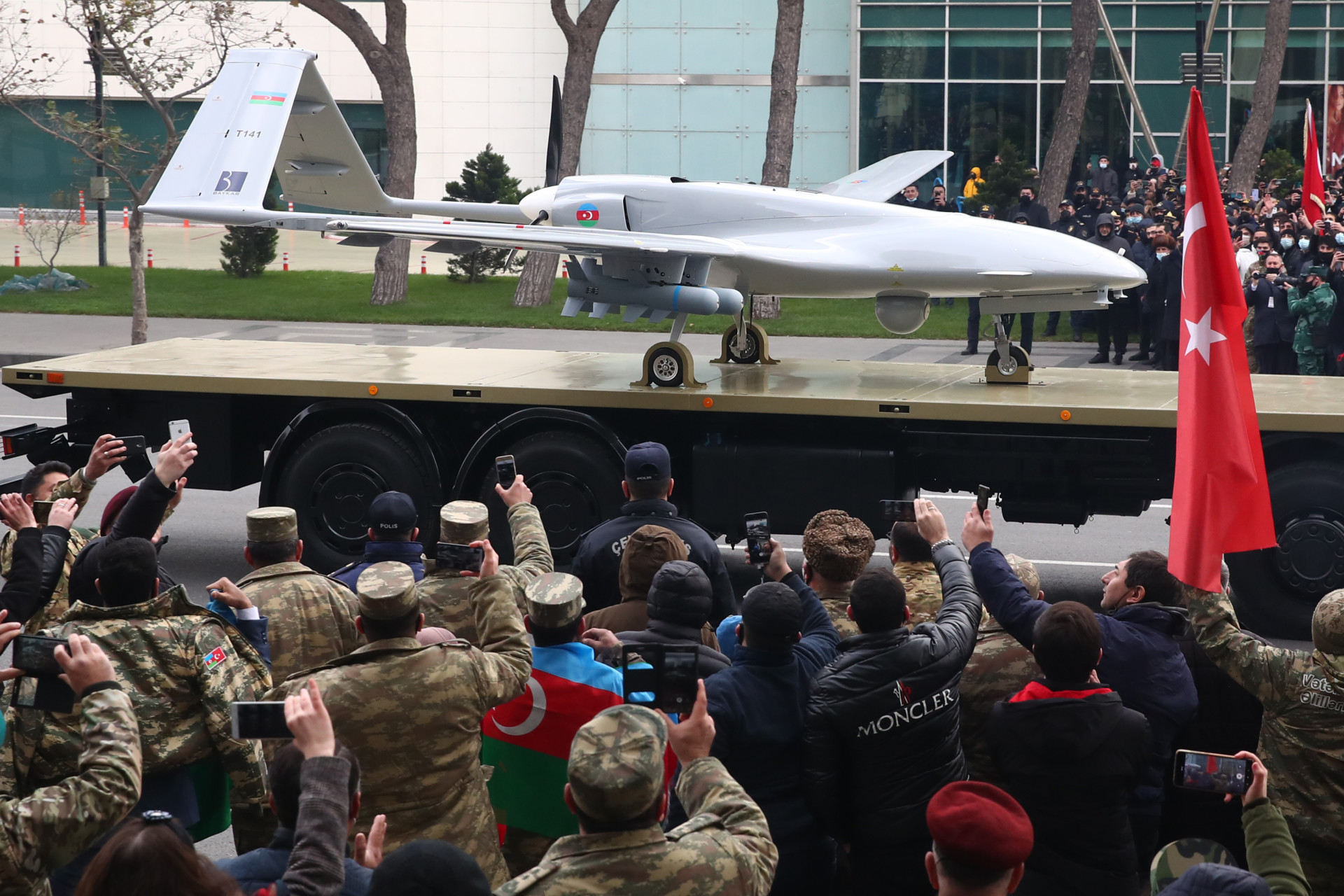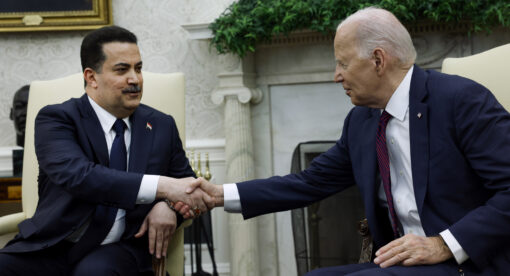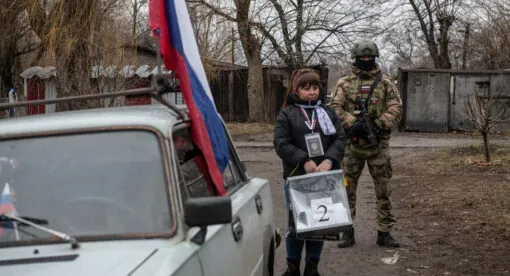The United States was once the leader in military drone technology, but its reticence to sell drones to other countries has left a gap in the market that authoritarian regimes such as China, Iran, and Turkey have been eager to exploit.
Authoritarian regimes are increasingly gaining access to the latest technology for unmanned aerial vehicles (UAVs), leading to their increased use not only by those regimes but also by nonstate actors, including proxies and militant groups. This trend means major defense alliances like NATO will need to increase spending on counter-UAV systems, and ungoverned spaces, previously dominated by drones used by the U.S., are now contested air space. This will impact how wars are fought and the types of drones being produced globally as an arms race has kicked off for this type of weapon system.
The top U.S. commander in the Middle East, Gen. Kenneth McKenzie, warned at a June 7 State Department special briefing about Iranian-backed militant groups shifting from using rocket attacks to drones to try to harass U.S. forces into leaving Iraq. It wasn’t the first time he had warned about the rise of the drone threat in the Middle East: In 2020, he warned U.S. senators that armed drones were the most important tactical threat since the improvised explosive device. Drones like the ones that are increasingly threatening U.S. forces in Iraq can provide authoritarian regimes and nonstate actors with a kind of instant air force and asymmetric threat, and they recently have played key roles in conflicts in Libya, Yemen, Azerbaijan, Syria, and Iraq. Their use by nonstate actors, including proxies and militant groups, is a unique threat because of the deniability it affords state backers of these groups and because it multiplies the types of weapons these groups now have access to.
Rapid Proliferation
More than 95 countries now operate military drones, up from 60 in 2010, and every year countries are adding more new drone units to their armed forces, from a few dozen special units that operated military drones in the 1990s to more than 270 today. The U.S. has led drone technology, pioneering drone warfare with systems like the Predator and the Global Hawk, but in the last several years Turkey, Iran, and China have made major inroads into the armed drone market.
This shift has had profound consequences for U.S. partners and allies because of Washington’s reticence to export its drones: Foreign sales of UAVs with a payload of over 500 kilograms were banned under the Missile Technology Control Regime, and sales needed a special waiver from the U.S. This led to U.S. drone manufacturers faltering while U.S. allies and partners, including Saudi Arabia, the UAE, and others, looked to China to fill their drone vacuum. By 2017, China was the third-largest arms seller, and Chinese drones were finding their way to the battlefields of Libya, Yemen, and elsewhere.
While Chinese companies were pitching their drones as low-cost versions of the U.S. Predator and Reaper, offering them often to authoritarian states and U.S. partners, Turkey and Iran were also entering the market. Drones were an inviting technology for these countries to invest in because it offered a new platform to innovate with, rather than trying to play catch-up against highly advanced systems like the F-16. These countries tend to be muscling their way into regional power status as the U.S. withdraws forces from places like Afghanistan.
Iran has had military drones since the 1980s, but the Karrar, unveiled in 2010 and originating with a western target drone, was its first armed drone. Iran excels at copying or reverse engineering captured drones and repurposing them to new missions. For instance, in 2011 Iran downed a secretive U.S. RQ-170 Sentinel; it now operates V-shaped copies.
By 2019, Iran was already using Shahed-129 drones in Syria and Iraq. The Islamic republic also had exported technology from its Mohajer UAV to Hezbollah and from its Ababil line of kamikaze drones to al-Houthi rebels in Yemen. Reports increasingly linked Iranian drone technology to increasing drone attacks on Saudi Arabia and drone use across the Middle East.
By 2021, Iranian drone technology was not only empowering al-Houthi fighters in Yemen but also was used for the first time by Hamas and was being increasingly used in Iraq to target U.S. forces. The U.S. and Iraq have not released many details about the type of drones the militias in Iraq are using to target U.S. facilities, but they are likely similar to the drones the Popular Mobilization Forces showed off at a parade on June 13, which included models that appear similar to Iranian drones such as the Ababil-3. In the hands of militias and nonstate groups, these weapons were also empowering authoritarian regimes such as the Assad regime in Syria.
“We’ve spent billions of dollars in the Department of Defense on counter drone systems,” McKenzie said in 2020. “I think the key thing is right now we’re simply at a stage in the development of systems, and you see it in the back and forth of warfare, where the advantage is with the operator and with the offense. We will catch up; it’s going to take us a little time to do that.” And in 2021, he said Iran was “resorting to this technique because they have been unable to force the government of Iraq to require that we leave. So political pressure has not worked for them; now they’re turning to a kinetic approach. And that is very concerning to me.”
In Turkey, the Bayraktar TB2 has been in service for several years and fundamentally revolutionized how Ankara has conducted warfare against militants and the Syrian regime during brief clashes in 2020. The drone has been sold to Ukraine and Poland and has been used in Libya, where it performed well against Russian Pantsir-22 air defense systems. This has received increasing coverage, as Turkey’s use of drones could herald a new way of warfare, making tanks and vehicles far more vulnerable. The use of the Bayraktar by Azerbaijan along with Israeli drones it has acquired over the years provided Baku with a kind of instant air force that decimated Armenian forces during the war in late 2020, enabling Azerbaijan to retake areas of Nagorno-Karabakh it has claimed since the 1990s.
Turkey’s drones have raised eyebrows for another reason: artificial intelligence. Reports in early June that a Turkish Kargu drone used artificial intelligence to hunt down and engage fighters have prompted fears that drones could be launched without a human in the loop, allowing them to search for and engage a target without anyone pushing a button. Artificial intelligence already gives drones the ability to scan with electro-optics and identify threats, but generally the system has a person who decides what to do next. (Kamikaze-style drones are a bit different – the drones Iran used to attack Saudi Arabia’s Abqaiq facility in September 2019 were given pre-programmed coordinates and simply flew to them and slammed into the target, like a cruise missile. In that case, the drone is not really using new technology, but old technology packaged in a new way.)
In the hands of authoritarian regimes or those that do not observe human rights controls, drones equipped with artificial intelligence could be unleashed by the dozens to hunt down civilians or perceived threats, or they could be programmed to attack certain types of people or search for certain characteristics. Terrorist groups like ISIS have used much simpler versions of drones, attaching grenades to commercially available drones. The question is when large nonstate actors like Hezbollah may acquire better technology and combine it with more lethal drones.
For now, the major lesson of the last decade is that countries willing to innovate and be flexible with military machines have developed impressive drones. China is exporting them in greater numbers, and Iran is proliferating the drones to its Middle Eastern partners. Turkey’s drones have surfaced in conflict in Libya and Azerbaijan, although its major drone sales appear for now to be directed at Central and Eastern European states.
Countering the Rise
The U.S. reluctance to export drones and attempts to control the technology have largely resulted in adversaries building their own innovative drone arsenals. China has shown its willingness to penetrate markets where the U.S. was slow to respond to the drone revolution. The implication is that this new technology not only will empower authoritarian states hunting down internal threats or those on their borders but also can be used for long-range asymmetric attacks, wreaking havoc globally.
The rise of drones being developed and exported by authoritarian regimes and proliferating among militant groups and nonstate actors presents a variety of challenges. Drone warfare has been central to destabilizing and spreading conflict in recent years, whether in Libya, Yemen, Syria, or Iraq. To counter these new threats, countries will need to invest heavily in counter-drone technology, often called counter-UAS (unmanned aerial system) defensive systems. This will require billions of dollars in investment and procurement in coming years. Many of the systems to counter drones already exist in one form or another, but they will need to be harnessed systematically and widely deployed. For instance, U.S. forces in Iraq have often not had air defenses to counter the variety of threats they face. Investment in counter-UAS tech, from lasers to systems that can stop drone swarms, will be key to facing the threat.
Agreements to stop armed drone proliferation appear to have largely failed to contain countries like China, Iran, or Turkey. That means that there will need to be a shift to documenting the use of drones, tracking them back to their sources – as has been done in the Yemen conflict – and providing countries that are being threatened with means to contain the drone threat. This new technology is maturing; soon, drones will be seen like other weapon systems such as aircraft or cruise missiles. They are more a novelty today in the hands of militant groups like Iran’s proxies, but as they mature and become the norm, and defenses against them are widespread, they will take on the characteristics of any other military hardware and the question countries will face is how best to use drones and counter them. Placing resources in the hands of air defenders, educating the public, and studying the impact drones will have will be essential for countries in the coming years.
Dr. Seth J. Frantzman is the executive director of the Middle East Center for Reporting and Analysis. Dr. Frantzman is also the Middle East affairs correspondent at The Jerusalem Post. Frantzman is the author of “Drone Wars: Pioneers, Killing Machines, Artificial Intelligence and the Battle for the Future (Bombardier Books, 2021)” and “After ISIS: America, Israel and the Struggle for the Middle East (Gefen, 2019).” His work has appeared in Foreign Policy, Bloomberg, The Hill, Defense News, The Spectator, The National Interest, among other noteworthy publications. He tweets at @sfrantzman
The views expressed in this article are those of the authors and not an official policy or position of Newlines Institute.







